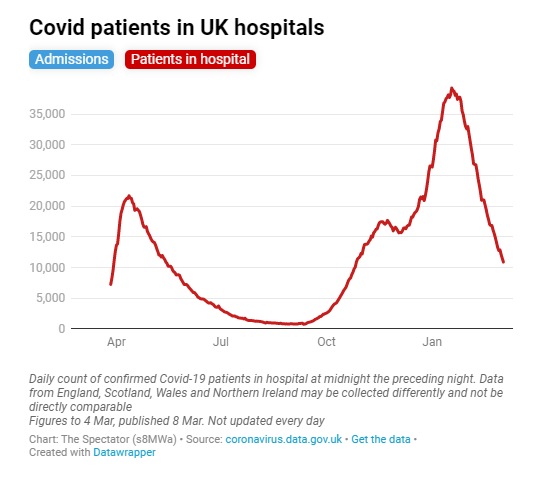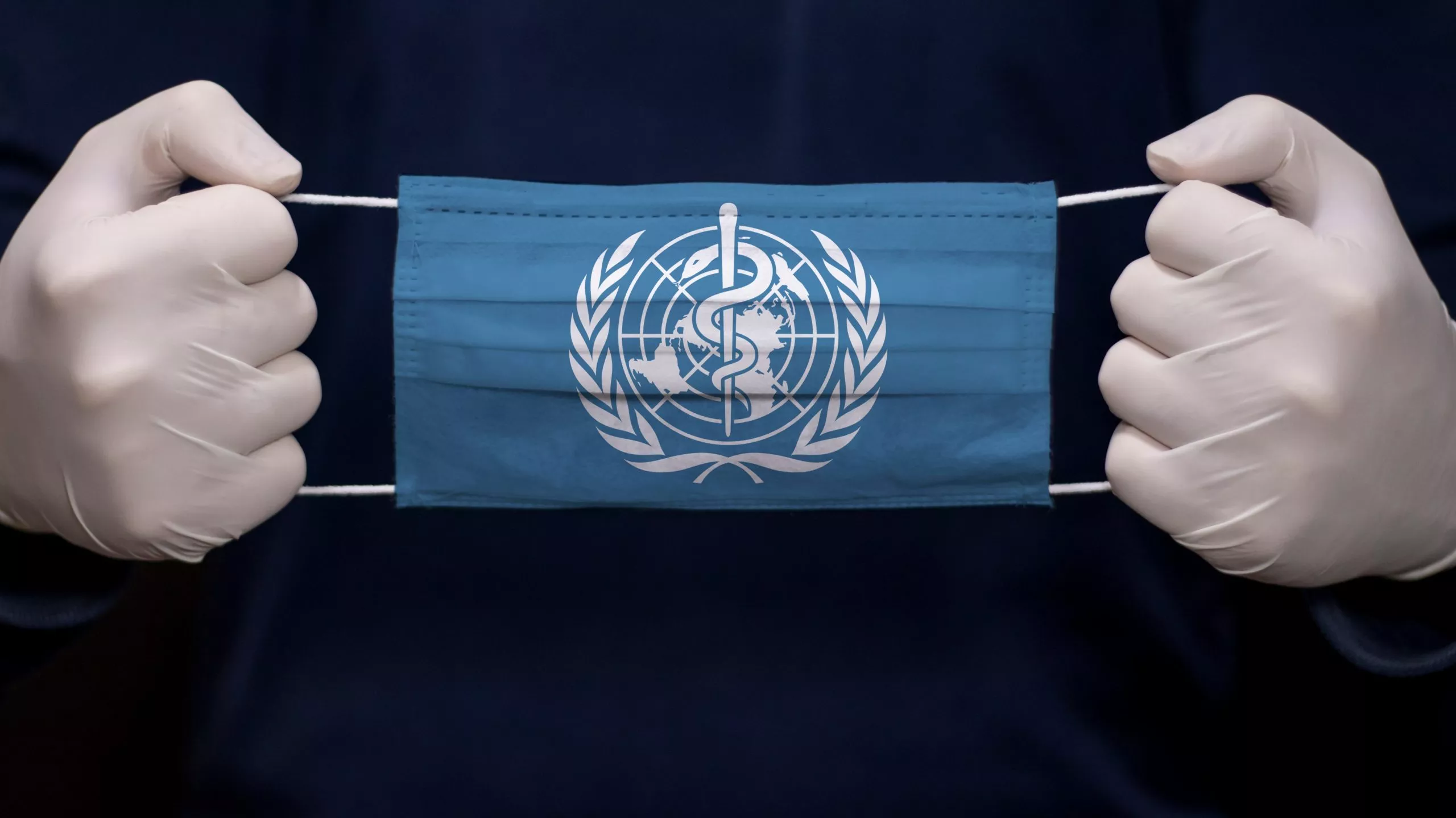Today Boris Johnson held a press conference to mark what he described as an “emotional” moment in the lifting of lockdown as children return to school. Encouragingly, he said that the “greater risk now is keeping them out of school for a day longer”.
Deputy Chief Medical Officer Dr Jenny Harries told the press conference that she didn’t expect schools to be forced to close again.
Less welcome was that she said it would take some families time to get used to the wearing of masks and regular testing, as though this was to be part of an ongoing normality.
On the plus side, she said the vaccination programme meant the R number was no longer so important.
The whole issue about vaccination of course is we have now protected the most vulnerable individuals as we come down the age groups into those with underlying health conditions. And so the impact on our hospitals going forward is likely to be significantly less.
She noted that cases, hospital admissions and deaths continue to fall, and that infections are now below 100 per 100,000 of population in every part of the country and are back to where they were in September.
She then reverted to alarmist nonsense, saying: “This is a level at which a new wave could easily take off from again”, and there is still “substantial strain” on the NHS.
In other words, everything’s going down – but don’t think that means you can resume your liberties, as it could reverse at any moment. On that logic, we’ll never be free.
As for the NHS being under “substantial strain” – Covid patient levels are back to where they were in October, when hospitals were running at normal levels, and dropping quickly.

The Government continues to spout this fear and doom narrative to justify its ludicrous decision to squander its vaccine advantage and lift lockdown at snail’s pace behind many other countries and US states.
The Adam Smith Institute (which, bizarrely for a libertarian think tank, supports lockdowns) estimates that every week of lockdown costs the UK Government £6bn and suppresses the economy by £5bn.
Kate Andrews in the Spectator has published this week new analysis which demonstrates the predictable relationship between strict lockdowns and dampened economic activity. She writes:
Lockdown has always been a matter of trade-offs. The impact of suppressing the economy to also suppress a deadly virus has had consequences on every aspect of life, from non-Covid health treatment, to rising unemployment, to the impact on children’s education. But these costs can be calculated in something much closer to real time. New data from the OECD, analysed by The Spectator and unveiled in this week’s magazine, shows the weekly difference between a country’s economic activity now and how it compares with the year before.
Here’s the key graph.

Spiralling costs and debt, children subject to absurd testing and masking regimes, ongoing alarmism about the return of the virus and hospital pressure, lockdown being lifted agonisingly slowly – yet plummeting cases and deaths, hospital admissions back to autumn levels and dropping, a world-beating vaccine programme, and the example of several US states ending restrictions with no adverse effect.
We’ve said it before and we’ll say it again: the Government’s approach is mind-bogglingly costly and makes no sense.










To join in with the discussion please make a donation to The Daily Sceptic.
Profanity and abuse will be removed and may lead to a permanent ban.
Only if you still believe this was ever about a virus.
If you still believe that it is about a virus, you are mind bogglingly stupid.
Why did so many die post jab then? 95% of the old were injected?
Why did 200K have injuries and why 400+ dead from the jab?
Never heard or seen a thing on this site or in the Fake News on the above.
Ridiculous.
‘We’ll never be free again’ . Well this bit of the article was correct.
The biosecurity fascist totalitarian regime will never ‘let’ us be free again. Its going to get worse, not better. All the bricks are being laid around us to keep us in this new prison world, with constant checks and constraints.
This is the latest revision of ‘capitalism’ , the one where its about competing for resources. The one that makes untold wealth for some who take advantage of pandering to our need for health security and war against ‘heat’.
But because its a capitalism based on resource constraints rather than the old model of resource exploitation, there are too many plebs with at present too many demands. The plebs have to be controlled and their ambitions constrained. So they have to be reeducated to love their new controls/constraints. Amazing progress in this in the last 12 months, but rather than ease up, it time to accelerate that process.
Wake up people, it may already be too late.
https://architectsforsocialhousing.co.uk/2021/02/19/cui-bono-the-covid-19-conspiracy/
Yes you are right. I really urge people to read this article by Elmer that was posted a while back. It’s a long read but brilliantly explains how the Corona cult has taken hold in ways that defy logic.
We need a wider perspective and to get to grips with the current revolution of capitalism. It is now at a very specific stage. It has always needed new markets for exploitation, but what is novel is that it no longer “needs” the freedom of the individual. Instead it needs to form a new social contract between the individual and the state. Elmer refers to Patrick Zylberman who wrote about ‘health terror ‘ back in 2013. The deal is that the state tells us it needs to look after our health safety and in so doing it erodes our freedoms.
This new paradigm is biosecurity and people who “socially distance” or wear masks etc are colluding with this notion of contagion. Human physicality is being phased out ….. we have not seen anything yet.
The contract is between global monopolism and its stakeholders.
The state is an extension of the monopoly that has no contract with people who are contracted by the state as global assets.
Private ‘partnering’ is PR for regulatory capture – that extends to state, media, and indeed any vector of influence. It works by delivering unto debt, through the hollowing race to the bottom under the technologism of system efficiency running within deliberate and opportunistic scarcities – real or imagined.
We each have a Covenant within our very Being, but may be contracted or recoiled from direct relational awareness and appreciation, by a masking protection set over and against lack and scarcity, (real or imagined).
But WHO told you you were naked? (said the Lord).
Fear and deceit give rise to coercion that sets up the conflicts that perpetuate fear and deceit and etc.
Truth is the basis for revealing freedom from deceits such that conflicts are resolved or reevaluated to practical terms, instead of being masked in or under cover stories that repeat the ‘trauma patterns’ of our particular dissociative strategies.
If anyone wasn’t here last night, they might be wondering where everyone else has gone. Most of the regulars have understandably taken exception to what Toby wrote yesterday in defence of his decision to break up the comments section. He said the General Comments had become “a bit of a toxic swamp that is damaging the site’s reputation and putting off respectable contributors.”
The admirable Mabel Cow has created a new home for defecting swamp creatures and they’ve moved over to: https://www.reddit.com/r/LockdownSceptics. Early days but it’s coming along nicely. Take a look. I haven’t actually joined up yet but will do so later.
I joined Reddit last night but so far have not had my application approved so unable to post. Anybody else have this issue? Loads of activity there, sorry about the changes here.
Dave, I think a few have had some minor delays but they get through in the end so this is probably a temporary glitch. 119 have signed up so far. Reddit will take some getting used to but there’s already quite a community feel developing. Just reading so far. Will join later when I can think of a suitable new username.
One of the swamp creatures has already set up a page so that new names can be listed alongside the names we were previously known as. It keeps the familiarity intact. Genius!
Now online at Reddit, thanks Mabel for your work. Guess this will be my last post here, thanks though to Toby for starting it all off but here will never be the same again.
Will be on there – this is the only forum I can get on in work so…… stuck here from 9-5
Mabel’s site now has 149 ex -LS swamp creatures.
Will Jones says:
“
Government’s Long, Slow Walk to Freedom is Costing Billions and Makes No Sense”I would suggest reframing from nonsense as a mindfuck to say:
Government’s long slow reconditioning to slavery is transferring billions while promoting nonsense as if a currency of real social exchange.
Down the page:
“
Covid Patients in English Hospitals”Patients in hospitals for whatever, tested positive for biomarkers that mean nothing and under testing parameters that are changed at whim.
Down the page:
Lockdown v EconomyMeans Choking and restructuring the Economy – and social structure.
Only engage scepticism to the point of recognising true from false.
Don’t think to ‘control’ hysteria, but establish the conditions for recognising the truth that undoes fear. The only life you can save is NOW. Saving from fear, dissociation and masking guilts and attack, is to live the life we have and are – from which comes living choices that support life. Fear phishes the mind to a misidentification such as to protect or save the fear from disclosure – under the belief or indeed fear that it is too big to be allowed to fail and so you must bail it out and sacrifice your life NOW for its ‘protection racket’. BUT once baited to emotionally invest, you will believe you are saved from a greater fear by aligning in the narrative of a masked off sense of self.
Don’t let fear of loss of face hold you hostage to helplessness. Let a mistake become a basis for hard lesson learned, and a sense of sanity and connection regained.
Without NOW as the opportunity to release the mind of a poor investment, we would be locked down in our thought, with no way out. That is the genius of ‘thinking’ – to always find a necessity or narrative under which to thinks some more. But if you want to listen for the revealing and guidance of truth now, thinking has to hush because you are no looking there NOW.
Live this day well!
Do you need permission to set your own intention?
Only from your self!
If you want to give power away, you can of course cast the blame accordingly, but true responsibility is not blame, but freedom. Releasing invested narratives is a process of willingness and active curiosity. Is there another way to look at this (whatever it currently appears to be)?
Releasing a mind-control is not really about what THEY are doing.
But as a fat and sitting duck, ‘they’ will use your willingness to be used.
Emotional reaction is NOT the basis from which to decide anything – or the world would have to conform to ‘hurt feelings’ or whoever has (or funds) the biggest stick.